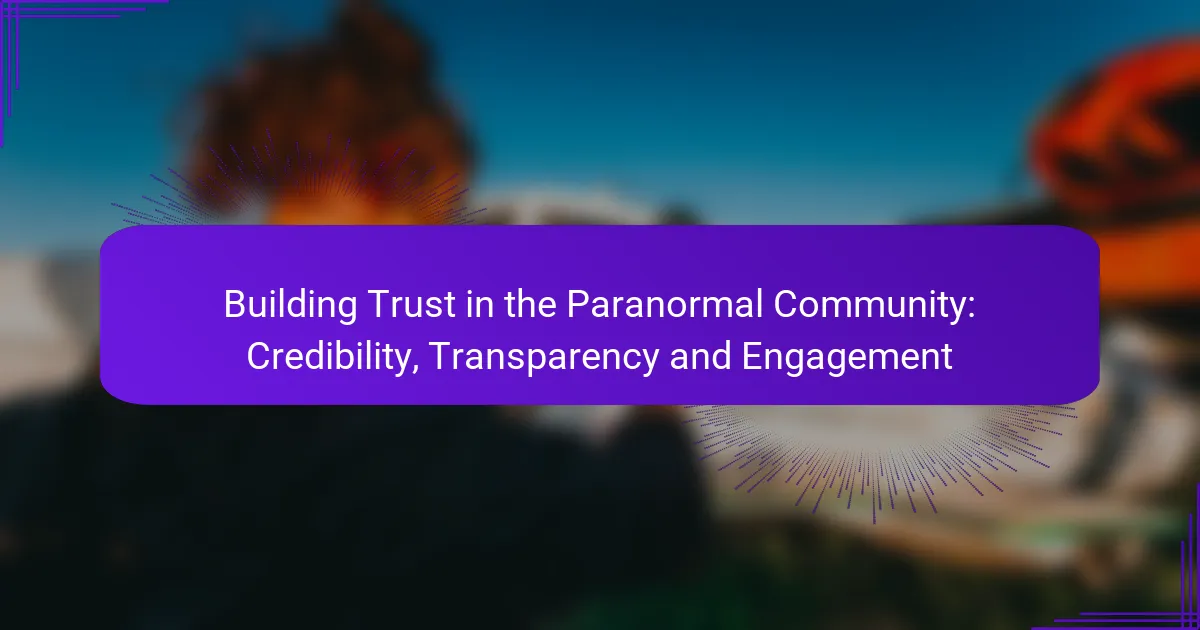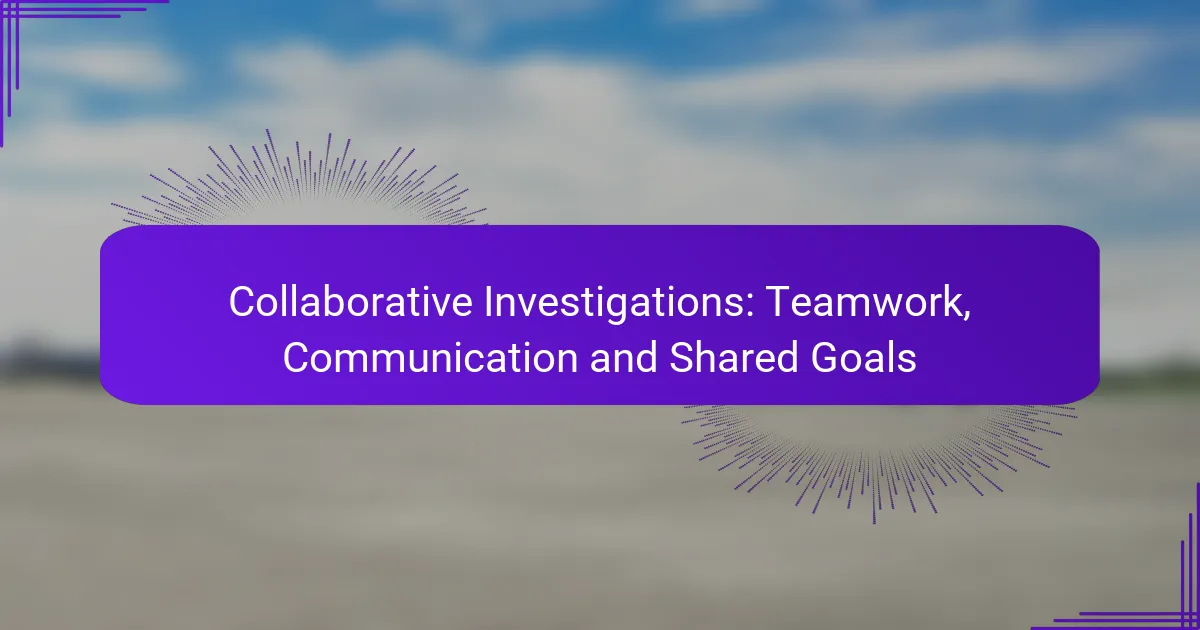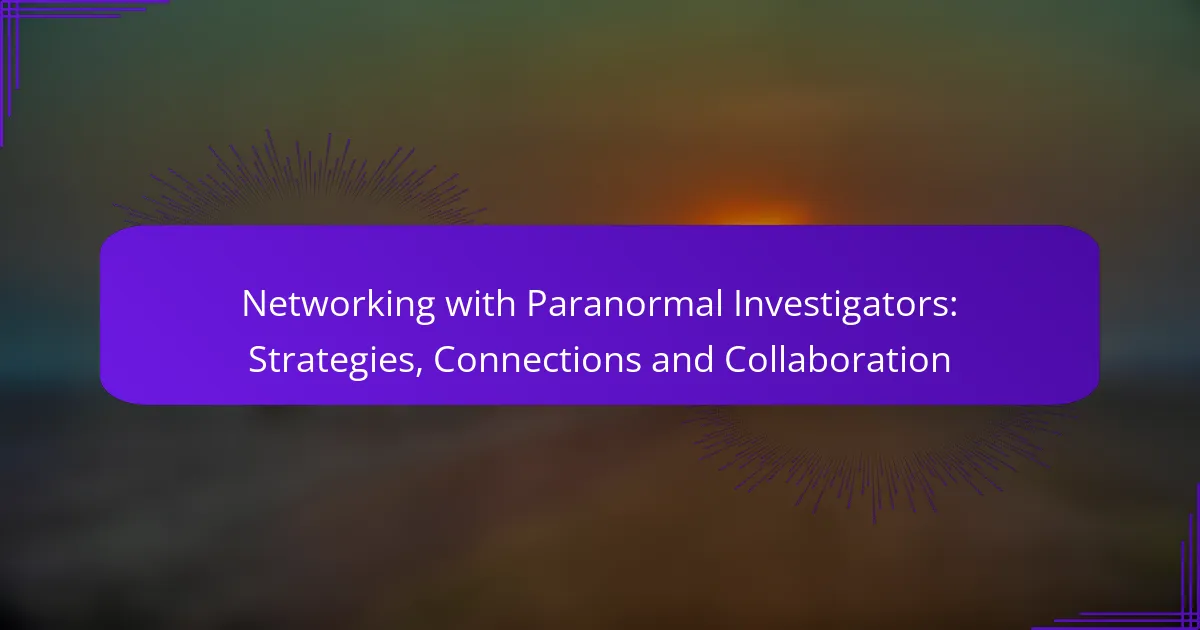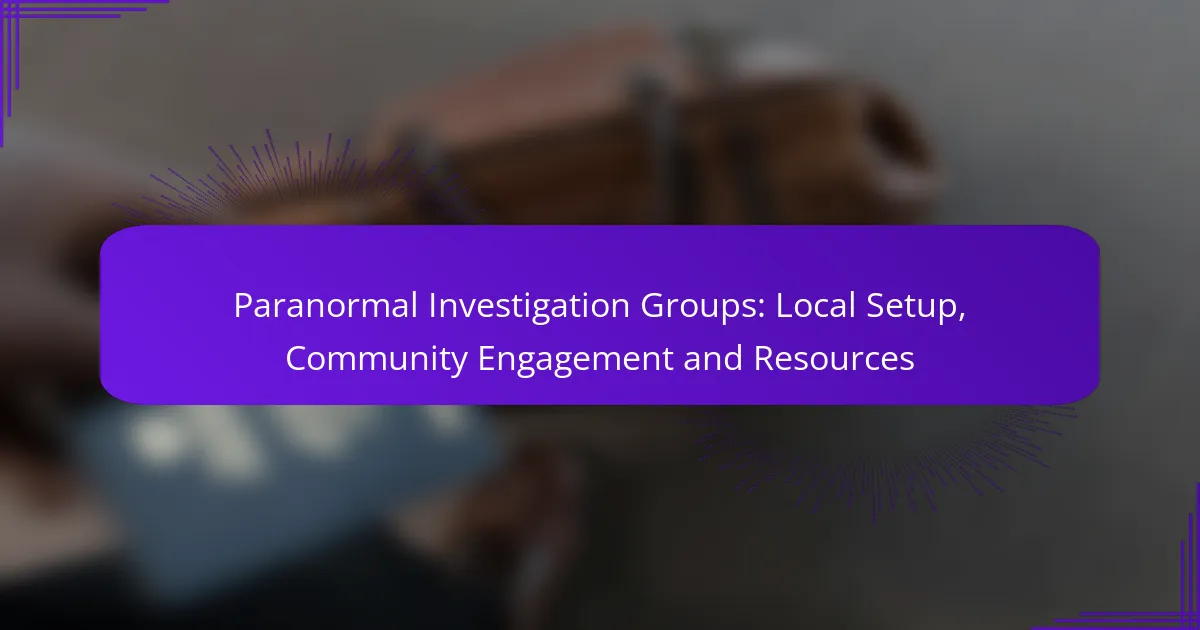Building trust in the paranormal community hinges on credibility, transparency, and engagement. By committing to rigorous research and open communication, practitioners can foster a respectful environment that encourages public involvement and confidence in their findings. This collaborative approach not only enhances accountability but also strengthens the overall integrity of paranormal investigations.

How can credibility be established in the paranormal community?
Credibility in the paranormal community can be established through rigorous research, collaboration with experts, and transparent practices. By adhering to these principles, individuals and groups can build trust and foster a more respected environment for paranormal investigation.
Utilizing verified research methods
Employing verified research methods is crucial for establishing credibility in the paranormal community. This involves using scientifically accepted techniques, such as controlled experiments and systematic observations, to gather evidence. For example, utilizing audio and video analysis tools can help validate claims of paranormal activity.
It’s important to document all findings meticulously, allowing others to replicate studies or verify results. This transparency enhances the reliability of the research and builds trust among community members.
Engaging with reputable experts
Collaboration with reputable experts can significantly enhance credibility. Engaging professionals from fields such as psychology, physics, or anthropology can provide valuable insights and lend authority to investigations. These experts can help interpret findings and ensure that methodologies are sound.
Networking with established figures in the paranormal field can also open doors to more rigorous scrutiny and validation of claims, further solidifying the community’s reputation.
Publishing transparent case studies
Publishing transparent case studies allows for open examination of paranormal investigations. Detailed accounts that include methodologies, findings, and interpretations enable others to assess the validity of the claims. Case studies should be written in a clear, accessible manner to encourage engagement from both skeptics and believers.
Including both successful and unsuccessful investigations in publications can also demonstrate honesty and a commitment to truth, which is essential for building trust within the community.
Encouraging peer reviews
Encouraging peer reviews is a vital step in establishing credibility. By inviting fellow investigators to critique work, individuals can gain constructive feedback and improve their methodologies. This process not only enhances the quality of research but also fosters a culture of accountability.
Creating a network where members can share insights and critiques can lead to higher standards and greater respect for the findings presented in the paranormal community.
Implementing ethical guidelines
Implementing ethical guidelines is essential for maintaining credibility in the paranormal community. Establishing a code of conduct that emphasizes respect for individuals, honesty in reporting, and responsible use of evidence can help prevent misconduct and promote integrity.
Regularly reviewing and updating these guidelines ensures they remain relevant and effective, fostering a trustworthy environment for both investigators and the public. This commitment to ethics can significantly enhance the overall perception of the community.

What role does transparency play in building trust?
Transparency is crucial in establishing trust within the paranormal community as it fosters credibility and accountability. By openly sharing information and methodologies, practitioners can demonstrate their commitment to integrity and encourage engagement from the public.
Open sharing of findings
Sharing findings openly allows the community to evaluate evidence and conclusions critically. This practice can involve publishing reports, videos, or articles that detail the results of investigations. When findings are accessible, it builds confidence among followers and invites constructive dialogue.
For example, a paranormal investigator might share a detailed case study on a website or social media, including audio recordings, photographs, and personal observations. This openness can lead to increased interest and participation from the community.
Clear communication of methodologies
Clearly communicating methodologies helps others understand how conclusions were reached. This includes detailing the tools used, the processes followed, and the criteria for evaluating evidence. When methodologies are transparent, they can be replicated or scrutinized by others, enhancing credibility.
For instance, if a team uses specific equipment to capture evidence, they should explain how that equipment works and why it was chosen. This clarity can demystify the investigation process and encourage informed discussions.
Disclosure of biases and limitations
Disclosing biases and limitations is essential for maintaining trust. Every investigator has personal beliefs and experiences that can influence their findings. By acknowledging these factors, practitioners can present a more balanced view of their work.
For example, a researcher might state that their previous experiences with a particular location could affect their interpretation of new evidence. This honesty allows the community to assess the findings with a more critical eye and fosters a culture of openness.
Regular updates on ongoing investigations
Providing regular updates on ongoing investigations keeps the community engaged and informed. These updates can include progress reports, preliminary findings, or changes in direction based on new evidence. Consistent communication demonstrates commitment and keeps interest alive.
For example, a paranormal team might post weekly updates on their website or social media, detailing what they have discovered and any challenges they face. This practice not only builds trust but also encourages community involvement and support.

How can engagement foster trust in paranormal investigations?
Engagement fosters trust in paranormal investigations by creating open lines of communication and collaboration between investigators and the community. When individuals feel involved and informed, they are more likely to trust the findings and methodologies used in these investigations.
Creating community forums for discussion
Establishing community forums allows enthusiasts and skeptics alike to share their thoughts and experiences. These platforms can be online or in-person, providing a space for dialogue that can demystify paranormal activities and enhance understanding.
Forums should be moderated to ensure respectful discourse and to prevent misinformation. Regularly scheduled discussions can keep the community engaged and informed about ongoing investigations and findings.
Hosting live Q&A sessions with investigators
Live Q&A sessions offer a direct line of communication between investigators and the public. These sessions can be held on social media platforms or through webinars, allowing participants to ask questions and receive immediate answers.
To maximize participation, promote these events well in advance and encourage questions beforehand. This not only builds trust but also demonstrates transparency in the investigative process.
Encouraging audience participation in research
Inviting the audience to participate in research can significantly enhance trust. This can include citizen science projects where community members help gather data or share their own experiences related to paranormal phenomena.
Providing clear guidelines and training for participants ensures that the data collected is reliable. Recognizing contributors publicly can also foster a sense of ownership and pride in the research process.
Building partnerships with local organizations
Forming partnerships with local organizations, such as historical societies or educational institutions, can enhance credibility. These collaborations can provide access to resources, expertise, and a broader audience.
Joint events, such as workshops or lectures, can help demystify paranormal investigations and present findings in a credible context. This not only builds trust but also strengthens community ties and support for future investigations.

What are the best practices for ethical paranormal research?
Ethical paranormal research involves adhering to principles that ensure the integrity of the research process and the protection of participants. Key practices include obtaining informed consent, respecting privacy, and responsibly documenting findings.
Obtaining informed consent from participants
Informed consent is crucial in paranormal research, as it ensures that participants understand the nature of the study and their role in it. Researchers should provide clear information about the research objectives, methods, potential risks, and the use of findings.
To obtain informed consent, researchers can create a consent form that participants read and sign before participating. This form should be written in accessible language and allow participants to ask questions. Always ensure that consent is voluntary and can be withdrawn at any time without penalty.
Respecting privacy and confidentiality
Maintaining privacy and confidentiality is essential in ethical paranormal research. Researchers must protect participants’ identities and any sensitive information shared during the study. This can be achieved by anonymizing data and securely storing any records.
Additionally, researchers should inform participants about how their data will be used and who will have access to it. Implementing strict data management protocols helps build trust and encourages more individuals to participate in future studies.
Documenting and reporting findings responsibly
Responsible documentation and reporting of findings are vital to uphold the credibility of paranormal research. Researchers should accurately record all observations and data, avoiding any manipulation or misrepresentation of results.
When reporting findings, it is important to present them in a balanced manner, acknowledging any limitations or uncertainties. Researchers should also consider the potential impact of their findings on the community and avoid sensationalism that could mislead the public.
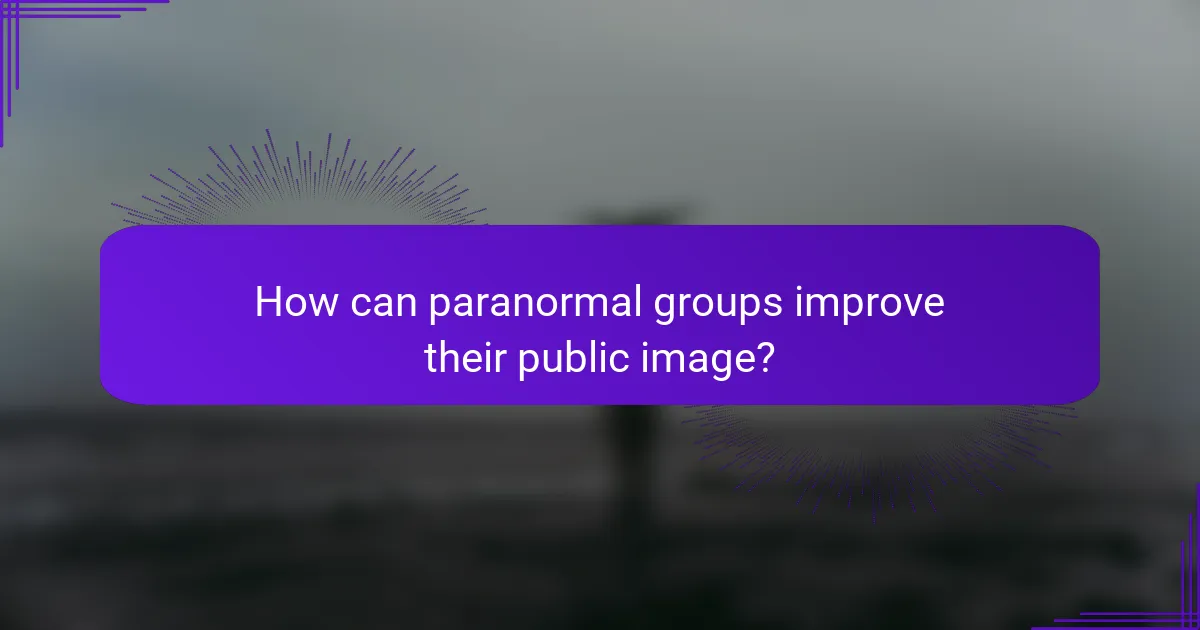
How can paranormal groups improve their public image?
Paranormal groups can enhance their public image by focusing on credibility, transparency, and community engagement. By actively participating in local initiatives and demonstrating their commitment to ethical practices, these organizations can build trust and foster positive relationships with the public.
Engaging in community service projects
Participating in community service projects allows paranormal groups to demonstrate their dedication to the community beyond their investigative activities. This involvement can include organizing clean-up events, supporting local charities, or hosting educational workshops about paranormal phenomena.
When planning these projects, consider the interests and needs of the community. Collaborating with local organizations can amplify the impact and ensure that the efforts are well-received. For example, a paranormal group could partner with a historical society to restore a local landmark, thereby promoting both community pride and interest in local history.
To maximize effectiveness, set clear goals for each project and communicate them to the community. Regular updates on progress and outcomes can further enhance transparency and trust. Engaging with community members through social media or local events can also help maintain a positive image and encourage future participation.
